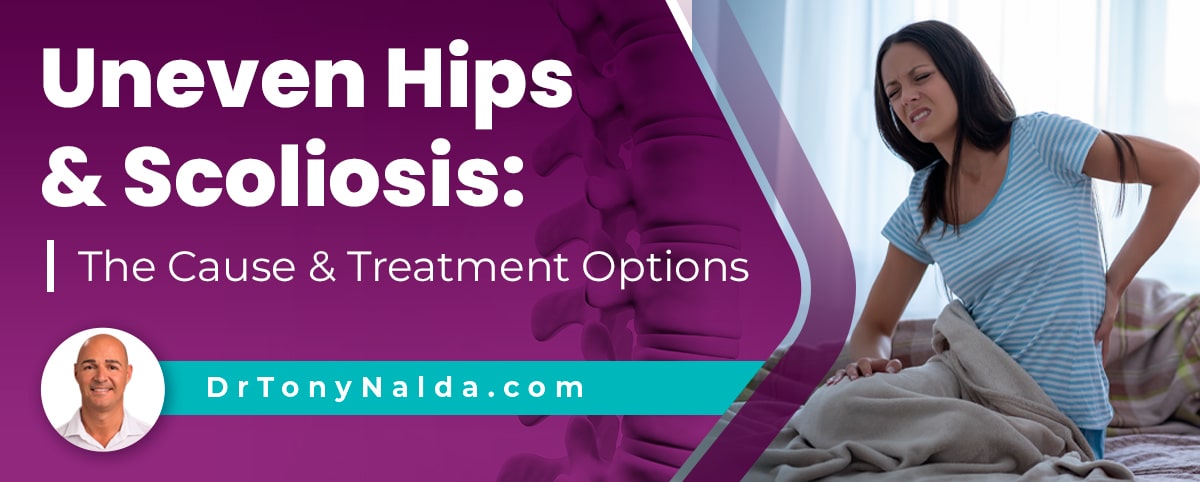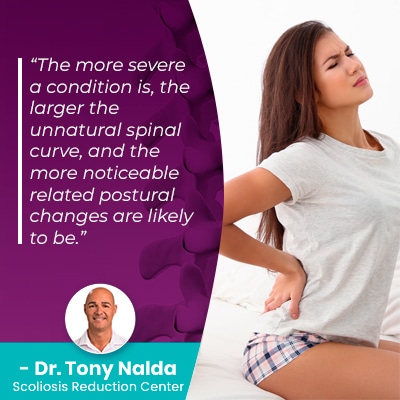Uneven Hips & Scoliosis: The Cause & Treatment Options

While there are never treatment guarantees, early detection increases the chances of treatment success. In order to recognize the condition’s early signs, attention has to be paid to the body’s natural symmetry. Uneven shoulders and hips are commonly among the first and earliest signs of scoliosis, and to remedy condition-related postural deviation, a proactive treatment that impacts the condition on a structural level is key.
Scoliosis introduces a lot of uneven forces to the body, and as an unnatural sideways spinal curve with rotation develops, a postural deviation is its main visual symptom. One of the condition’s earliest telltale signs are uneven hips, as scoliosis disrupts the body’s overall symmetry.
Let’s start our discussion on uneven hips and scoliosis by first exploring what it means to be diagnosed with scoliosis.
Table of Contents
Being Diagnosed with Scoliosis
In order to be diagnosed with scoliosis, certain parameters have to be met; an unnatural sideways spinal curve has to be present, with a rotational component, and a minimum Cobb angle measurement of 10 degrees.
A patient’s Cobb angle is a measurement obtained during X-ray that tells me how far out of alignment a scoliotic spine is.
Scoliosis is a highly-variable condition, meaning no two cases are going to be the same and have the same treatment needs; this is partially because scoliosis ranges from mild to moderate and severe to very severe.
The higher the Cobb angle, the more out of alignment the spine is, and the more noticeable postural changes, like uneven hips, are likely to be.
At the mild level, postural changes are often subtle and difficult for anyone, other than a specialist, to notice, and functional deficits at the mild level are rare.
In addition, in children and adolescents, the condition isn’t commonly known as painful, and this is due to growth and development.
When a spine is still growing, it’s experiencing a constant upward lengthening motion, and that counteracts the compression caused by the unnatural spinal curve, as it’s compression of the spine and its surrounding muscles and nerves that causes the majority of condition-related pain.
While postural deviation is the main symptom of scoliosis in children and adolescents, pain is the number-one symptom in adults: both back pain and radicular pain felt throughout the body, due to compressed nerves.
Another key condition characteristic is its progressive nature, meaning it will get worse over time, particularly if left untreated, or not treated proactively.
 The more severe a condition is, the larger the unnatural spinal curve, and the more noticeable related postural changes are likely to be.
The more severe a condition is, the larger the unnatural spinal curve, and the more noticeable related postural changes are likely to be.
Severe scoliosis often leads to uneven hips, a condition that can cause discomfort and limit mobility. This imbalance may also contribute to scoliosis and sciatica, where the sciatic nerve becomes irritated or compressed.
It's important for individuals with scoliosis to be aware of scoliosis exercises to avoid, as certain movements can worsen the uneven hips or exacerbate the condition.
Scoliosis treatment by age varies, with different approaches tailored to the patient's stage of life and the specific scoliosis curvature types. Understanding these nuances is key in effectively managing and treating the condition.
How Does Scoliosis Affect the Hips?
Remember, scoliosis isn’t just an unnatural sideways spinal curve, but also involves rotation, meaning the spine twists from front to back, back to front.
Uneven hips, also known as lateral pelvic tilt, can develop as the pelvis leans more to one side; this prominent lean to one side is characteristic of scoliosis as it disrupts the body’s center of gravity and overall symmetry.
When the pelvis leans more to one side, rather than forwards or backwards, it can cause uneven hips by causing one hip to be pulled upwards, while the other is being pulled downwards.
As the hips are impacted posturally, they are no longer sitting parallel to the ground and shoulders above, which is why uneven hips tend to present with uneven shoulders; as one hip is pulled downwards, the one shoulder blade on the same side of the body is being pulled upwards.
As progression occurs, a condition is increasing in severity, and the unnatural spinal curve is increasing in size, increasing the uneven forces felt by the body, and this increases related postural changes.
Scoliosis fatigue can often be accompanied by hip pain, making it essential to manage both symptoms for a better quality of life.
Adolescent idiopathic scoliosis (AIS) is the condition’s most prevalent type, diagnosed between the ages of 10 and 18, and uneven hips are one of its most-noticeable symptoms.
As the spine bends and rotates, it pulls on the rib cage and pelvis, disrupting its position, and this can cause one hip to sit higher than the other, which can cause one hip to seem more rounded, the other flatter.
So now that we understand how scoliosis can cause the hips to become uneven, what are the options for fixing the postural issue?
How to Fix Uneven Hips Caused by Scoliosis
When it comes to fixing uneven hips caused by scoliosis, the best remedy is proactive treatment that, first and foremost, impacts the condition on a structural level.
Here at the Scoliosis Reduction Center, I approach postural deviation as a symptom of the larger underlying structural nature of the condition, which is why I first strive to impact the condition structurally, and once I see those results, I can start working towards increasing core strength so the spine is optimally supported and stabilized.
 By integrating multiple condition-specific treatment disciplines such as chiropractic care, in-office therapy, custom-prescribed home exercises, and corrective bracing, I can customize treatment plans to address important patient/condition characteristics such as patient age, condition type, curvature location, and condition severity.
By integrating multiple condition-specific treatment disciplines such as chiropractic care, in-office therapy, custom-prescribed home exercises, and corrective bracing, I can customize treatment plans to address important patient/condition characteristics such as patient age, condition type, curvature location, and condition severity.
Through chiropractic care, I can manually adjust the most-tilted vertebrae at the apex of the curve back into alignment with the rest of the spine, and this restores as much of the spine’s healthy curves as possible.
Through in-office therapy and custom-prescribed home exercises, I can help patients increase their core strength so the muscles that surround their spine can support it optimally.
In addition, certain scoliosis specific exercises (SSEs) are known to activate specific areas of the brain for improved brain-body communication, postural remodeling, and better body positioning.
Corrective bracing, such as the ScoliBrace, can help augment corrective results by holding the spine in a corrective position.
Through applying these forms of proactive treatment, a curvature reduction can be worked towards, which changes related structural symptoms, such as postural deviation and uneven hips.
Now, for those who choose to follow a traditional scoliosis treatment approach, spinal fusion surgery is a common recommendation, but many patients are disappointed with its cosmetic results, particularly when it comes to the hips.
Why Doesn’t Scoliosis Surgery Fix Uneven Hips
While there are many reasons a patient might opt for spinal fusion surgery, the number-one reason is cosmetic; people want their pre-scoliosis bodies back and assume that surgery is the best option.
However, many people are disappointed with the cosmetic results, particularly when it comes to the hips, and once the spine is fused, cosmetic results will vary based on a number of important factors: condition severity, patient age, condition tpe, curvature location, and the number of vertebrae fused.
It’s impossible to know how a patient’s body will respond to spinal fusion in terms of posture and body symmetry, but most people can’t expect a full return to their pre-scoliosis bodies.
Part of the reason surgery can’t completely fix any and all condition-related postural deviation is that spinal fusion doesn’t actually correct a scoliosis; instead, when successful, it stops the condition from worsening, and it does this by eliminating movement in the fused section of the spine and holding the spine in position with rods attached to the spine with screws.
Bodies can have new posture post-surgery, and some can take time to settle; in terms of curvature location, lumbar scoliosis can cause excessive pelvic tilting, making it more difficult to restore even hips because the pelvic-tilt factor was more extreme at the time of fusion, thus more challenging to address.
Ultimately, the spine is the focus of scoliosis surgery, and while when successful, it can make a crooked spine straighter by holding it in place, its ability to restore symmetry to all areas of the body affected, including the hips, is limited.
Conclusion
Many individuals notice that they have an uneven waist or asymmetrical shoulders, which can be concerning both aesthetically and functionally. This imbalance often manifests with one shoulder, for instance, the left shoulder, appearing higher than the right or the right hip being higher than the left. Uneven shoulders occur due to various reasons, such as imbalances in the upper trapezius muscle or misalignment in the shoulder blades.
These imbalances can also cause one to think that their left hip is higher than the right, even if the primary issue lies in the shoulder region. Fortunately, there are ways to treat uneven hips and fix uneven shoulders. Approaches on how to fix unaligned hips or how to fix an uneven waist typically involve targeted exercises and stretches that address the core and surrounding musculature. With the right guidance, individuals can strengthen and balance these muscles, alleviating the apparent height difference in the hips or the tilt in the shoulders.
Hypolordosis can contribute to uneven hips and exacerbate the effects of scoliosis, further emphasizing the importance of proper spinal alignment for individuals with these conditions.
When it comes to uneven hips and scoliosis, we’re talking about how the uneven forces introduced to the body disrupt its overall symmetry and create muscular-skeletal imbalances.
In adolescents, uneven hips and shoulders are among the earliest telltale signs of the condition, and being aware of these early symptoms can lead to early detection, which increases the chances of treatment success.
As an unnatural sideways spinal curve develops and increases in size, it pulls on the pelvis, making it lean more to one side, which causes one hip to be pulled upwards, while the other is pulled downwards: uneven hips.
When it comes to addressing uneven hips, and other forms of condition-related postural deviation, proactive treatment that impacts the condition’s underlying structural nature is key.
Through a conservative chiropractic-centered treatment approach, I can help patients achieve a curvature reduction on a structural level and increase core strength so the spine is optimally supported and stabilized, and by doing so, related visual changes, such as uneven hips are also reduced as the unnatural spinal curve decreases in size.
Dr. Tony Nalda
DOCTOR OF CHIROPRACTIC
After receiving an undergraduate degree in psychology and his Doctorate of Chiropractic from Life University, Dr. Nalda settled in Celebration, Florida and proceeded to build one of Central Florida’s most successful chiropractic clinics.
His experience with patients suffering from scoliosis, and the confusion and frustration they faced, led him to seek a specialty in scoliosis care. In 2006 he completed his Intensive Care Certification from CLEAR Institute, a leading scoliosis educational and certification center.
About Dr. Tony Nalda
 Ready to explore scoliosis treatment? Contact Us Now
Ready to explore scoliosis treatment? Contact Us Now





